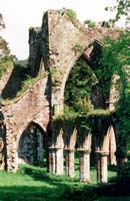
 |
| Calder Abbey | |||
|---|---|---|---|
 Calder
Abbey is a beautiful ruin set in secluded private grounds beside the River
Calder. This is a quiet western dale that has the brooding presence of the
Sellafield nuclear complex at its seaward end.This very seclusion adds to the fascination
of the sandstone remains in the verdant Calder valley near Calderbridge. Calder
Abbey is a beautiful ruin set in secluded private grounds beside the River
Calder. This is a quiet western dale that has the brooding presence of the
Sellafield nuclear complex at its seaward end.This very seclusion adds to the fascination
of the sandstone remains in the verdant Calder valley near Calderbridge.The abbey ruins can be seen from a nearby road and a footpath by the river but detailed exploration can only be made with the landowners permission. Calderbridge's retired vicar and acknowledged 'expert' on the Calder Abbey, the Rev. Joe Johnson, who became to the local parish incumbent in 1957.(Just weeks before all the atom plant workers suddenly evacuated in buses as the 1957 fire broke out!) He recalls the history of the abbey. *It was first founded in 1134 and grew to be the driving force in the local community up until Henry the Eighth dissolved the monasteries in 1536. Sir Thomas Leigh (a knight) was the man sent by King Hal to turf out the monks and take over the valuable farms and estates. *The story goes that when the monks were booted out they went to Furness Abbey but the Abbot there wouldn*t let them in unless they agreed to the Calder Abbot being demoted. The monks would not agree to this and so they trekked on to another monastery in Yorkshire.** The Rev Johnson points out one of the many features of the Calder site: *Half way to the village of Calderbridge is a stone called the Sanctuary stone. If any criminal or man on the run reached that stone he could claim sanctuary and safety.** In more recent centuries Rev Johnson says the Senhouse family built a large stately home, Abbey House, alongside and incorporating some of the stonework from the old abbey in the eighteenth century. *There is still a passage underneath the stately home that leads to one of the original Monk*s cells.** It is understood the abbey ruins and the stately splendour of Abbey House were sold in the 1960s for the princely sum of £5,000 to a buyer with landholdings from Cleator.(Burns Lindow estate) *Dr Parker*s history of the Gosforth District devotes an entire chapter to Calder Abbey. The stone abbey was largely built in the years up to 1210 after an earlier abbey had been wrecked by those marauding Scots in one of their many Away Day visits to Cumbria! Plans show that the abbey was laid out around a square cloister courtyard. On the north side of these cloisters was the main church, complete with a high church tower. The basic structure of this main tower has just about survived the combined effects of yet another Scottish raid by Robert Bruce (of Braveheart fame) in 1322 and generations of stone robbers. The cloisters also had around them the complex of buildings that made these early monasteries the main economic and cultural power houses of England in the Dark Ages. The ruins include those of a library, refectory, chapter house, dormitories and House of the Lay Brethren. There would no doubt have been extensive gardens, rich salmon and trout fishing in the Calder and almost limitless grazing for flocks of sheep. All this controlled from the abbey, which King Henry decided was ripe for a successful Take over bid. Another hidden gem that is private and not open to the public is Millom Castle in South Cumbria. Informative website on the Calder and Furness abbeys. |
|
|
|
Copyright © Lakestay All rights reserved.